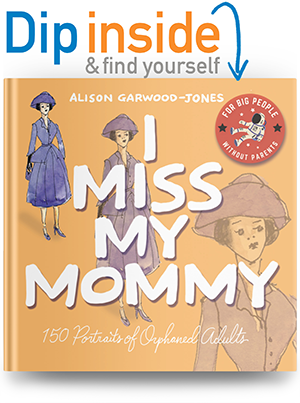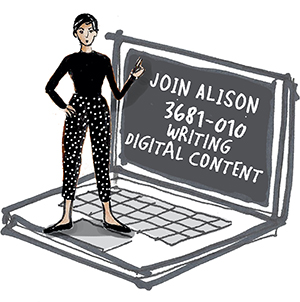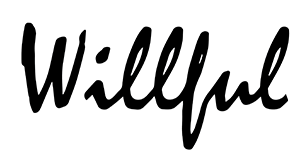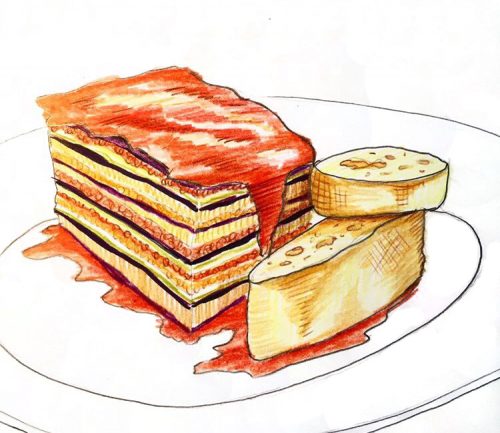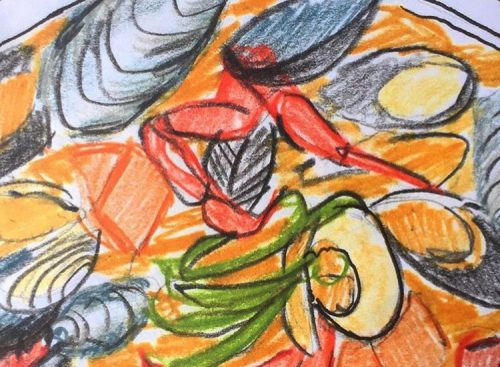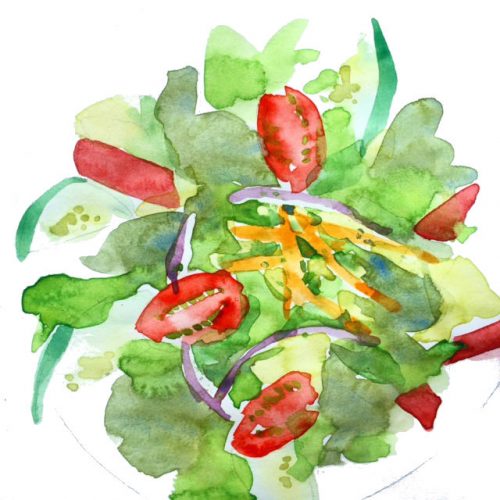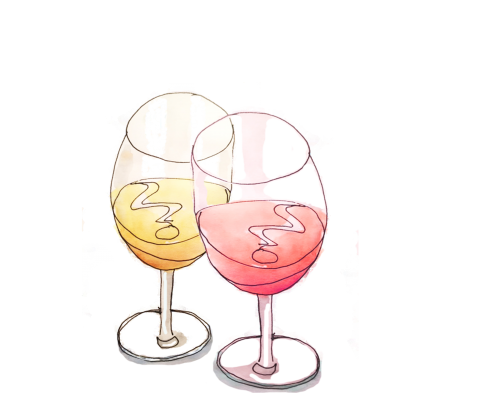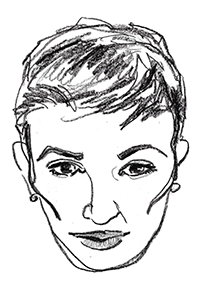More on loving your job
June 17, 2014
He was all shiny and aquiline when he walked up to the lectern.* His face was pulled tighter than a drum. Jeff Koons, Julian Assange and Andy Warhol stood backstage and watched. Meanwhile, a team of caterers behind some swinging doors at the back were preparing to serve us His Menu of grilled salmon and blueberries. But we couldn’t eat until he had spoken. Our bosses told us to take detailed notes. The PR team putting him up was treating him like a Nobel Laureate. Everything about this felt wrong. Like, 911-wrong. Smart people I liked were pointing to him and nodding. My eyes bore into them as if to say, ‘Are you kidding me?’ They kept silent while the down payments on their mortgages accumulated. He laughed and snarked from the lectern, making us feel bad about ourselves while purporting to make us feel good. This man and his wares belonged in a museum of discarded scams, next to the butt-shaking exercise belts (but not the Victorian vibrators because they may have sorta worked). He kept us there for way longer than 15 minutes. And during question period, this Warlock of Syringes told us: “I’ll tell you what women want: only a beautiful woman is a satisfied woman.” He was bringing his promises to the Provinces. But we weren’t the land of Trophy Wives and Supermodels. Celebrities were as rare here as alligators in bathtubs. Still, he was determined to capitalize on time’s passage and expand his reach to librarians, streetcar drivers and tired moms for he too had a mortgage. Actually three: New York, Miami and Gstaad. He finished with a campy joke, and the PR team led the room in a thank you clap. He left the stage to lacklustre applause and promptly had a hissy fit behind the curtain. Jeff and Julian went “there, there,” and gave him a punch in the arm and a playful knee to the groin. Andy just stood there with his arms crossed, shaking his silver wig. Just then, the caterers came bounding through the swinging doors carrying trays loaded up with our identical lunches. The tension subsided a bit as the clank of the dishes took over. “Tighty whitey” — that’s what I was calling him — had returned to the room wearing a tiara and was now ignoring everyone at the head table, including the PR people doing figure eights around him. For the next twenty minutes, he stabbed the blueberries on his plate and checked his phone. After that he left. So did I.
*Parts of this are true. The rest was a dream.
What Employers Are Looking For
November 20, 2023

This morning, a smart student reached out and asked if she could join me for Office Hours later this week. She wants to know, “What are employers looking for right now?”
People who sign up for my digital strategy and writing courses quickly learn that I believe in the Church of Creativity and Eternal Learning, but I suspect she is reacting to those times in class when I let honesty get ahead of hope with nakedly chilling statements like:
“Marketing is an absolute mess right now.”
And,
“You’re here because you know that writing is the best way to assert your agency and figure out what you know. And if you feel a bit sick right now that’s because AI has turned both of those things upside-down.”
By the way, it doesn’t feel right calling this colleague “a student,” although she is enrolled in my “Writing Digital Content” course at the University of Toronto (SCS).
And, while I’m technically the instructor, the only thing I’m in full control of right now are the admin settings on our recurring Zoom meetings.
As for knowing what the future applications for writing and content marketing will be, no one individual or institution is hoarding all the answers, although some pretend to judging by their ads.
Here’s what I do know: you can proactively research what needs are not being met in companies, pick one, and get really good at that. Before you know it, you’ll be standing in front of them shaking your Christmas bells and singing, “I’ve got a tool that can transcribe that podcast for you in less than a minute. Next, have you considered …?”
Your can start your research here. Last week, Deloitte’s Future of Canada Centre dropped a report — Digital Equity: Empowering All Organizations to Succeed in the Digital Era — citing a list of needs employers are having a tough time filling.
The report, conducted between August 2022 and March 2023, interviewed 804 Canadian senior business leaders in the private, non-profit and public sectors, with special attention on small and medium-sized enterprises.
It asked leaders what their biggest ongoing employee challenges were. Remember, those challenges could be your next job. All you need is the courage to put in the prep work, then pitch yourself as the solution (even when you don’t feel ready yet):
Job Opportunity # 1:
67 per cent of organizations with over 10 employees say hiring digitally skilled workers is somewhat or very challenging, which rises to 70 per cent for medium (100-499 employees) and large organizations (500 employees or more).
Here’s Your Chance to:
Enrol in university continuing ed classes to keep improving your digital literacy and your mindset towards tech. Remember to showcase your updated certifications on LinkedIn while you are pitching future employers. And if you are currently enrolled in classes that teach you how to update and expand your digital skills, well then, you are ALREADY DOING what future employers need you to do so they can hire you! Remember: companies today are hiring for skills, not degrees (my two degrees are in Art History, for crying out loud).
Job Opportunity #2:
A majority (58%) of survey respondents say uncertainty about which technologies would be most beneficial to their organization is somewhat or very challenging. Challenges include a lack of in-house specialized tech experience to shape digital strategies in areas like SEO, Data Analytics, and AI apps that improve customer insights and decision-making.
Here’s Your Chance to:
Fire up your research and writing skills and commit to building a list of the SAAS products currently trending your industry. Do you have your eye on company with a mission you admire, but whose tech know-how may need updating? The answers to who this company is, what they need, and what SAAS tools might serve them best is a LinkedIn, ChatGPT and Google search away. Reach out and find out how their tech transformation is proceeding, and offer your help. BTW: People who come to my classes identifying as Writers and Comms Professionals have their eyes opened during sessions on Generative AI use cases, SEO tactics, navigating Google Analytics 4 and a sprinkling of UX design. Yes, we talk specific tools.
Job Opportunity #3:
The report says companies who are having troubles finding and retaining digital talent need to think strategically about their talent value proposition and how it can speak better to digital and tech talent – including by being purpose/mission-forward.
Here’s Your Chance to:
Remind yourself what SMART objectives are, how you set them, why they are essential to business growth, and why you should ask a company to share its business objectives with you. Do they align with your values and what impact will this work have beyond the company? My Digital Comms Strategy Course tackles SMART Objectives and demonstrates how they provide a road map to help navigate people, processes, and systems.
Job Opportunity #4:
The Canadian Federal Government has funding to help support digital adoption in the workplace, but companies aren’t accessing it, either because their programs were never marketed properly, their webpages weren’t optimized for search, their application process wasn’t sufficiently streamlined, or All of the Above.
Here’s Your Chance to:
Build a Google Doc linking to all the current available government funding programmes, and make it public. Then pitch the development director or CFO of a non-profit you’d like to work at and find out if they are aware of this cache of untapped funding? Your research and reporting abilities could get you in the door.
Job Opportunity #5:
Progress is lagging on laws and policies that accelerate digital adoption.
Here’s Your Chance to:
Think about a career in public policy at Innovation, Science and Economic Development Canada (ISED). IP law, with a focus on AI and copyright, will also provide you with years of opportunities.
The report goes on to show opportunity gaps in other areas including: data protection and privacy, cybersecurity, and connectivity in rural and low-income communities. I’ve only highlighted a few to get you started.
In the meantime, keep your mind and heart open and look for ways that workplace knowledge and operations are falling behind.
The Right Purse
April 4, 2023
I buy a new purse about once or twice a decade. Yesterday I bought two (TWO!) in the span of an hour. No more spending until 2033.
You see, I moved into my brick-and-beam condo without checking the closet space. A walk-in is for other people. I have a shoulder-in closet and a ton of stuff rammed under my bed.
I signed on the dotted line for my condo because I open the front door to the sight of two (TWO!) six-and-a-half-foot tall windows that offer a “big sky” view of Toronto’s west end and, at sunrise, the distant gleaming skyscrapers of Mississauga, which I’ve taken to calling Hoboken from my perch (snooty, I know).
In the past few weeks, I’ve been running to these windows every time I hear the oncoming honks of a trio of Canadian geese, back from wherever because it’s spring here in Toronto. As they fly past and head towards Lake Ontario, I get a very intimate view of their fat, fuzzy bellies, blinking eyes, and poo drops ( like B-17 bombing raids over Europe during WWII). The theatre through these windows never disappoints.
But let’s get back to the purses, which I have taken to displaying on my bookshelves because of the closet problem. The first two are a pair of beauties I purchased yesterday at Toronto’s annual Vintage Show at the historical Canadian Exhibition grounds. The colourful one is a hard shell with a snap clasp covered in a swirly silk scarf pattern that dates back to about 1962. I’m sure its previous owner paired it with white cat’s-eye sunglasses, a crinoline dress or pencil skirt with a matching sweater, and kitten heels.
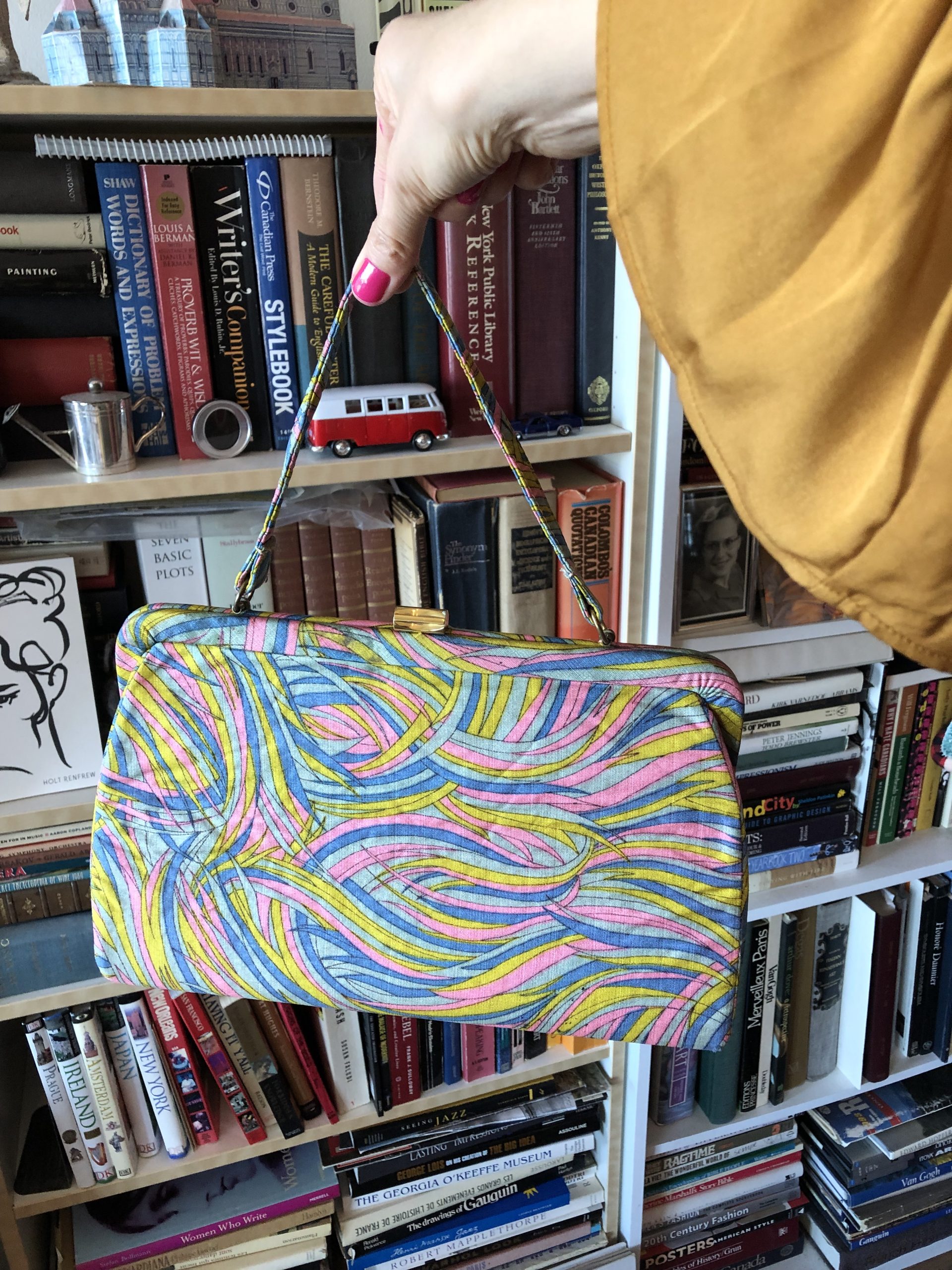
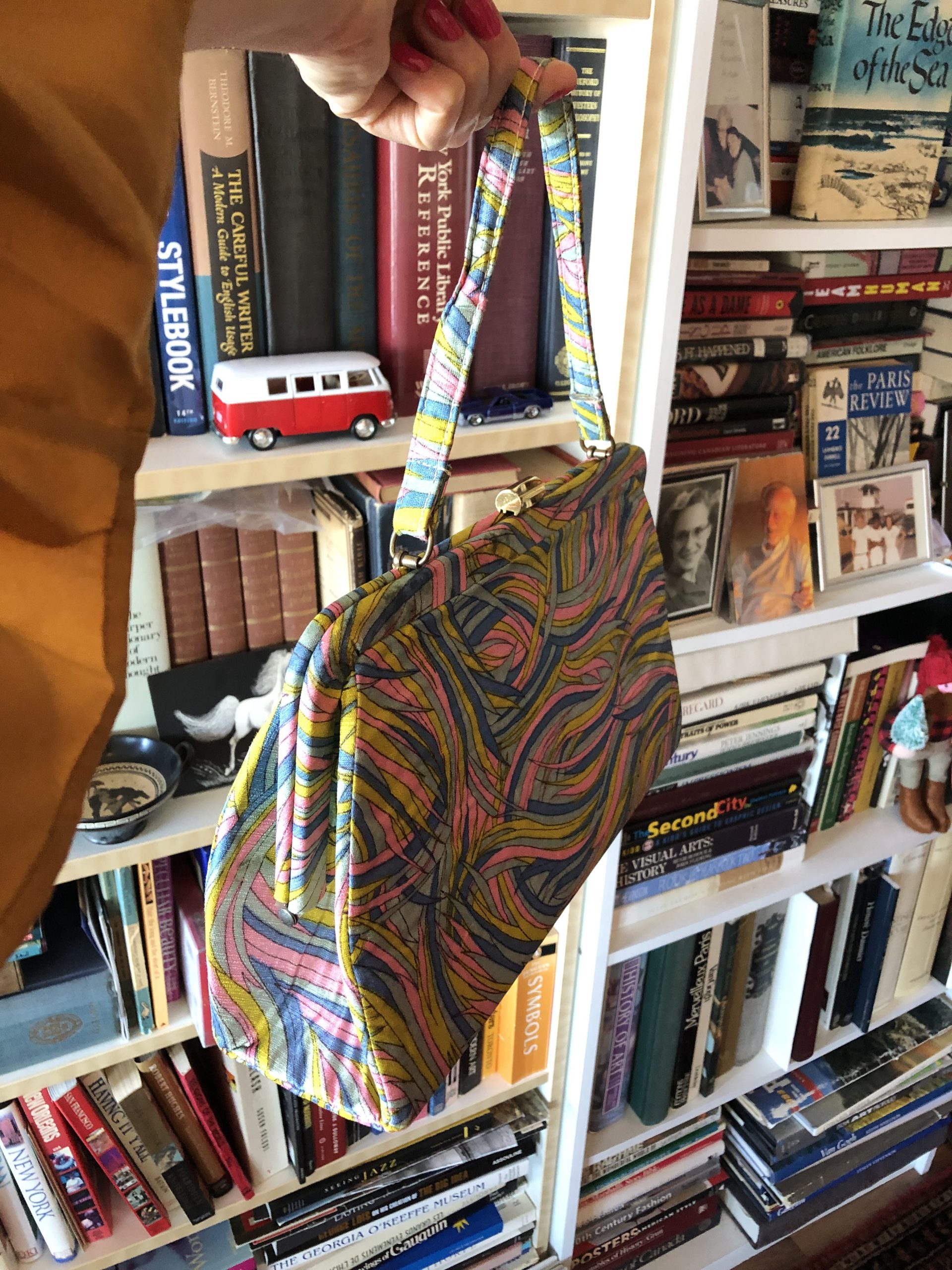
The second is a black evening clutch with the perfect gold bow clasp. It was made in Montreal by Paramount bags.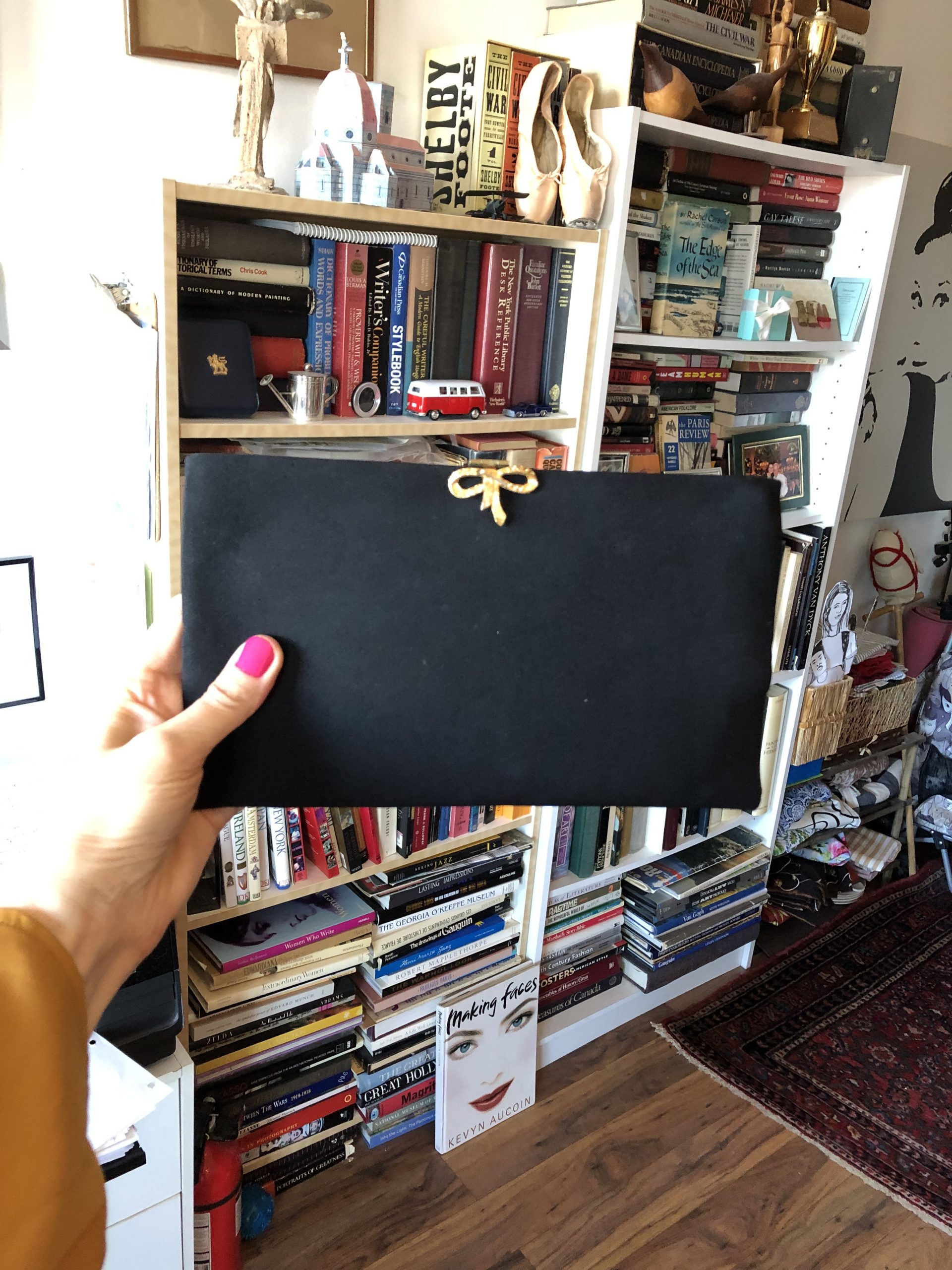
My God, its elegance is off the charts. And look! Inside there’s a gold satin change purse for those shiny pennies that the Canadian mint stopped making years ago. Back then, a few quarters went a long way. Beyond the change purse, there would have been a powder puff and a Kleenex square, and maybe a breath mint. I will fill this envelope with my iPhone, a credit card, the Kleenex square, and that universal tube of red lipstick that has been empowering us girls since forever.
The third purse was purchased from the same show about 15 years ago. Note: As my hair gets threaded with more silver, I’ve kept my cougar accessories to a minimum. But this was a rare instance where I said, “Take my money!” Now hear me roar!
The swirly purse enjoyed date night last night. She sat on the bar top next to a glass of Barolo. As a final touch, I’m going to take her to my favourite cobbler and ask him to add feet to her flat base. I want her to rise above the messiness of life.
Her Last Photo
September 12, 2022
Queen Elizabeth II: 1926-2022
Her smile was the same. Those girlish pointed canines that thousands of royal banquets and teeth-grindingly close horse races had never worn down.
The eyes were the same, merrily locking with the camera lens as if Cecil Beaton — her mother’s favourite camera-toting popinjay— had just zhuzhed up the flower arrangements and poked the fire into a roaring blaze.
The hunch was deeper. That still felt painfully new.
But it was the backs of her hands that announced the end was nigh.
They were an alarming deep purple, a colour that intensified the solitaire sparkle of Philip’s devotion, shining like a dying star on her left hand.
That got brighter on her way out.
It is these universals that inconveniently gloss over the centuries of arrogance and entitlement that the role of Monarch embodies.
It is why people, like me, with parents who were her exact contemporaries — he from England, she from the Cape Colony of South Africa, where Princess Elizabeth gave her famous 1947 “whether my life be long or short” radio address — have felt weepy these past few days.
It is these universals that make me slip on my mother’s engagement ring, custom-designed in London in 1949 by a pipe-smoking architecture student.
His sketches hoisted three very decent-sized diamonds atop a system of flying buttresses as breathtaking as Canterbury Cathedral, which he visited on his motorcycle during several thesis research trips. Mum typed up his final thesis comparing English and French Gothic architecture.
For a nation and a bombed-out city that was still rationing milk, lard, eggs and chocolate, its young men refused to cheap out on diamonds. Meanwhile, ridiculously practical women like my mother were ok with that.
As with the death of a Queen, sometimes in life we look the other way and just feel.

How I Can Help You
January 16, 2018
Writing & Digital Strategy Instructor
I’m an instructor (online and in-class) at the University of Toronto’s School of Continuing Studies. I teach Foundations of Digital Communications Strategy and Social Media and Writing Digital Content. In 2021, I was awarded an Excellence in Teaching Award – Business and Professional Studies from the University of Toronto (SCS).
Art Instructor
I also love to teach online and in-person art classes.
This class was with Jamii Esplanade, a non-profit community organization in Toronto.

This online class was for alumni of Toronto’s Rotman School of Management at the University of Toronto.
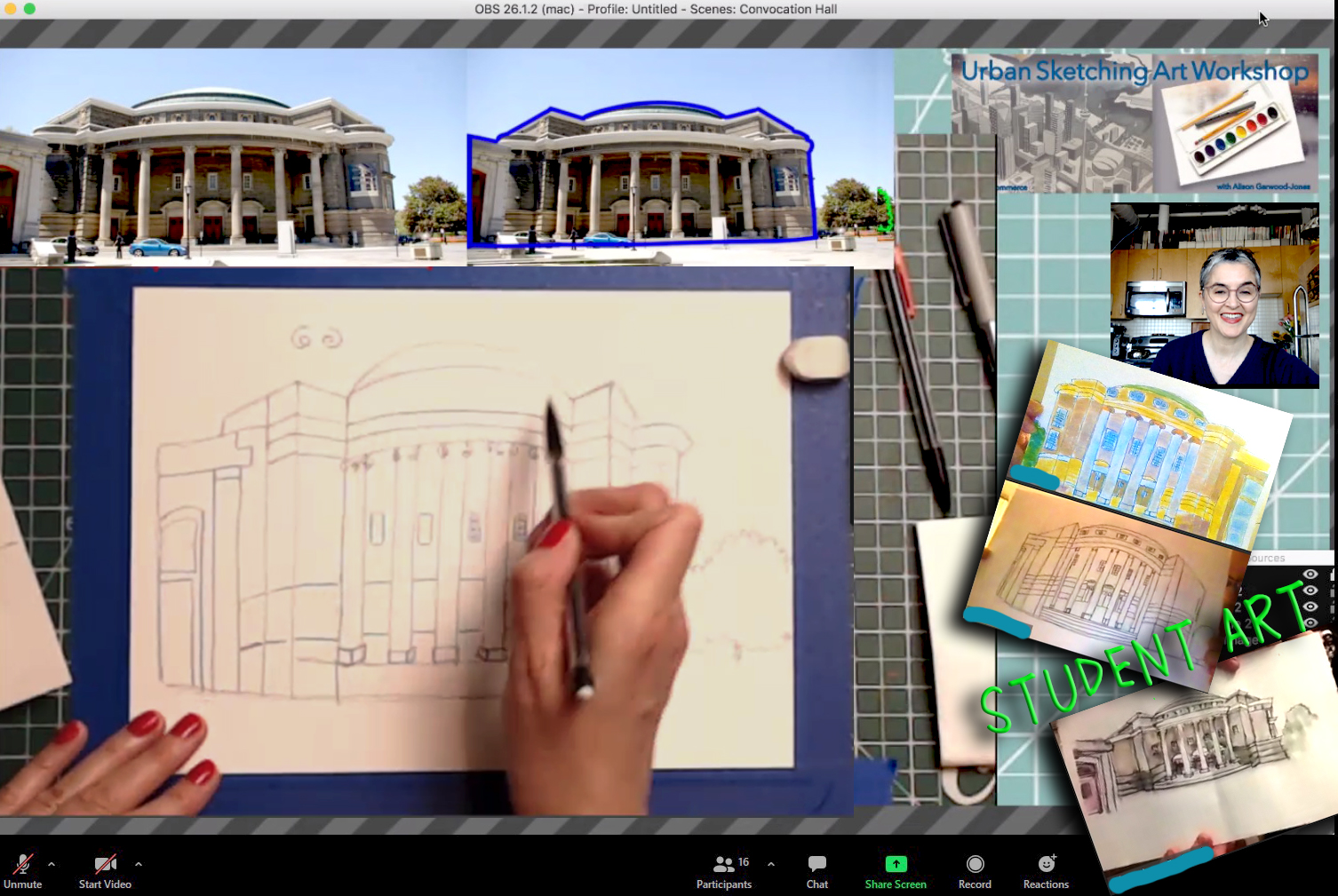
My YouTube series, The Ink Spot, offers 60-second art lessons:
Content Marketing
I help brands tell stories that address customer questions, needs, and concerns in a fresh and compelling way. Since content marketing is a “relationship-building, awareness-making, loyalty-boosting tool,” and not a direct sales tool, we will not be telling stories about why folks should buy your product. Old fashioned push marketing is (a) not engaging, (b) not useful to your target audience, and (c) annoying. Some of my past clients have included The Merchant Tavern and The Art Canada Institute, and a growing number of former print journalists.

I’m a big fan of Kat Gaskin’s physical Content Planners.
Custom Profile Illustration
Does your bitmoji express the real you (even with 1.9 septillion options)? Not in my books. Hand-drawn portrait illustrations catch the flutter of your spirit and reveal your hidden strengths way better than the frozen stare of digitized art. Email me if you’re looking for a custom illustrated portrait for an About Page, social media profile, or just for your wall. This form explains how to order your one-of-a-kind likeness. Note that the starting price goes up for complicated portraits.
Graphic Recorder
As an artist consultant and graphic recorder to brands and non-profit organizations, I provide a fresh perspective for those looking to clarify their marketing message or solve a problem, be it organizational, financial, social or cultural. I have worked with TEDx c0nference (female momentum in society), Lean In Canada (tackling gender bias and diversity in the workplace) The City of Toronto, (crafting a gender neutral budget), The Merchant Tavern (new menu items) and Montecito (window art).
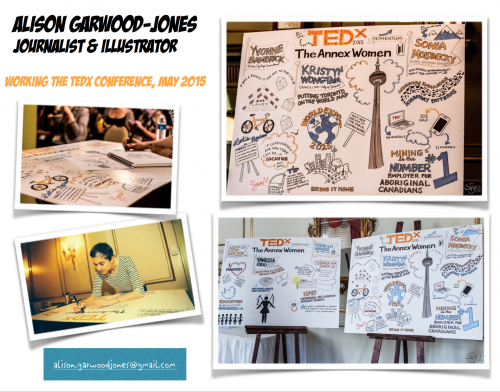

 That’s me with Kristyn Wong-Tam after the Gender Equal Budget meeting, January 2017.
That’s me with Kristyn Wong-Tam after the Gender Equal Budget meeting, January 2017.
Still not convinced? I made this short video to explain the difference an artist consultant can make for organizations looking to forge new strategies and business outcomes:
Speaker/Workshop Leader
I am a workshop leader and conference speaker on content marketing and social media strategy and tactics for brands and freelancers. Clients have included the Ontario Colleges Higher Education Summit, the University of Toronto’s School of Continuing Studies, IABC Toronto’s PIC (Professional Independent Communicators), PodCamp Toronto, OpenText, the Professional Writers Association of Canada, the Canadian Media Guild, and Bishop’s University (Morris House Reading Series, SWEET).
Advisor
I am also a member of the Program Advisory Committee for Social Media Week Toronto and The School of Media Studies and Information at Humber College. As a member of the Quadrangle Society, I mentor Junior Fellows at Massey College at the University of Toronto.
Accessible Design in Canada
August 30, 2016
FIFTY YEARS AGO, graphic design meant two things: working in print and kicking out mind-blowing creative. Wait, make that three: insisting on your own vision. The brash antics of Madison Avenue’s “Big Idea” branding campaigns, personified by George Lois and his “my way or the highway” client dynamic, have long since been replaced by a more cautious, self-conscious, albeit powerfully democratic push toward user-focused (UX) design, with its emphasis on utility, accessibility and user satisfaction. In Ontario, accessible (or inclusive) design is the law.
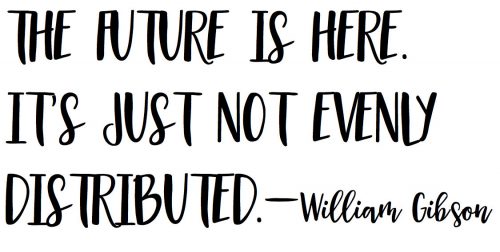
Accessible design has set itself a lofty mandate to leave no one behind, while serving the widest range of permanent and temporary accessibility issues imaginable—from visual, linguistic, auditory and motor to vestibular, cognitive and everything in between. Proponents like to joke that if you plan to live past the age of 45, then UX’s clear fonts, generous point sizes and proper colour contrasts are for you! Heck, if your optometrist has sent you into the subway system, eyes flooded with pupil-dilating drops, inclusive design is your friend, too. “Basically, we’re building the future for ourselves,” says Adam Antoszek-Rallo RGD, the founder and creative director at Catalyst Workshop, Inc.
At a time when Internet access is being upheld by the general public and the United Nations as a basic human right, Ontario is surpassing Madison Avenue, Silicon Valley and all of Europe in defining and developing how inclusive design should look, act and feel for print, web and the built environment. “I’ve done Google Trends searches on ‘web accessibility,’” says David Berman RGD, “and I’m amazed how Toronto and Ottawa come up as top cities on the planet.” Berman, who was the RGD’s first elected president, is currently a GDC Fellow and a roving consultant on the logistics of implementing accessible design in all contexts. He’s worked with the Canadian, Irish, Mexican and Omani governments, to name a few, and “Everyone is saying, ‘How do we replicate Ontario’s success?’”

Of course, not all designers are as gleeful as Berman by their province’s leadership and knack for good governance. Who hasn’t heard a colleague, drink in hand, moan at some industry event how accessibility is “the bane” of their existence? Meanwhile, having to explain to a client why a particular font or hue doesn’t pass the test is a common scenario. As Stüssy Tschudin, the RGD’s current president and principal of Forge Media + Design, sees it, “The province’s accessibility standards may limit our pure graphic approach, but they force us to think about how our work is going to function in the real world, and that’s an improvement on our design abilities.” Antoszek-Rallo agrees: “It’s an opportunity and body of knowledge that’s growing all the time.” Work, he says, can get boring after a while. “You end up repeating yourself. But this challenges us to make our creative better and resonant with more people and more consumers.”
The paradigm shift toward accessible design started with the passing of The Accessibility for Ontarians With Disabilities Act (AODA) in 2005. At the time, Queen’s Park gave government offices, businesses (with a minimum of 50 employees), non-profits and public sector organizations until 2025 to become fully accessible. It bears mentioning that these standards are non-existent in the rest of Canada. Manitoba has an act but no regulations yet, Nova Scotia is working on legislation, and BC is “a long way off,” says Berman. Still, there’s hope: the federal spring budget saw the government commit to restoring millions of dollars to greater accessibility and to creating a Canadians With Disabilities Act.

All along, the RGD has played a key role in figuring out how to explain accessibility, govern it and make sure it goes well. In 2010, in conjunction with the Accessibility Directorate of Ontario, the RGD published an easy-to-read handbook covering accessible design for print, web and environmental graphics (see sidebar, p. 34). This was followed by a second, web-only accessibility handbook that riffs on Web Content Accessibility (WCAG 2.0), the accepted international standard on web accessibility. “Accessibility is also a part of the certification process for all our members,” says Tschudin.
In the four years since fully accessible websites were mandated (any website built in or after 2012 must comply with WCAG 2.0 standards—see sidebar, above), a growing number of designers have found ways to push the rigid guidelines further than “do-good” design, to design that’s actually good. “You can’t treat WCAG 2.0 like it’s the Holy Grail,” Antoszek-Rallo explains. “It’s a man-made document written in 2006 before the first iPhone came out. We should be thinking beyond it.” Berman agrees: “If you follow everything, you lose your typographic tone of voice.” Both challenge designers to do better than Arial and Helvetica, the two most recommended typefaces. Experiment, says Antoszek-Rallo. “Find a style that works for the sighted and users with limited sight.” To get away with italics (a WCAG 2.0 no-no), he says, “You need to bold it and increase the amount of letter spacing.” This is not about ignoring compliance. “I just think there’s a difference be-tween the rules and the spirit of the rules.” When it comes to italics and typefaces, designers need to figure out where and when and how. “We should be thinking of the people who need it,” says Antoszek-Rallo, “but use our tools, like the No Coffee Chrome Extension (see sidebar, above), to test what actually works.”

As for print, “[accessibility] is on the minimal side,” says Tschudin, and mostly about contrast, font choices, point sizes, hierarchy and non-glare printed surfaces, most of which were relevant before inclusive design thinking. “The main parts we’re interested in, and testing for, are web and environmental compliance.” And the blending of the two. Donna Saccutelli’s problem solving in information design, in collaboration with Seneca College’s Paul Schecter and Jutta Treviranus at OCAD’s entrepreneurial hub, Imagination Catalyst, show we are on the cusp of a redesigned landscape and retail environment where Universal Product Inclusive Codes (UPiC) printed on packaging are closing the loop between the physical world and the cloud. Provided their phone’s native accessibility settings are turned on, they get a readout of the product name, brand, ingredients and nutrition facts. Saccutelli even hopes to embed brand jingles into the app so the blind can hear Tony the Tiger’s “They’re great!” when they pick up and scan the Frosted Flakes box. “We’re creating a store that’s turned on,” she says. As William Gibson famously said, the future is here—it’s just not evenly distributed.
As William Gibson famously said, the future is here—it’s just not evenly distributed.
This article originally appeared in the August issue of Applied Arts Magazine.
Poolside
June 21, 2016
 Pool Tiles by Alison Garwood-Jones
Pool Tiles by Alison Garwood-Jones
Los Angelenos have never waited for nature’s ice block to melt. Their blue horizons dance and sparkle all year round.
Torontonians watch, stare and tentatively strip to expose their chicken skin the moment the city pools drop down their Open signs. Lineups form around the block. Every body type joins the parade.
Here come the breasts like beach balls, the Ashkenazic chest pelts,* the melting hourglasses, the afros that hold at least two cups of pool water and the kids with their slippery dolphin skin.
The kidlets dive bomb. The adults, being Canadian, test the water first (even though it’s temperature-controlled). We can’t escape nature’s grip on our psychology.
Try telling L.A. in the front seat of her convertible that everything is not possible, and expect a toothier grin, a narrowing of the eyes behind her aviators and foot press on the accelerator.
Tell that to a Torontonian and he’ll say, Well, duh.
But for the next three months, everything is possible. So long as it’s not too hot.
*I didn’t come up with the term, “Ashkenazic chest pelt.” That was Martin Short describing Eugene Levy’s bare chest in the 1972 Toronto production of Godspell. It frightened the children in the audience, so Levy agreed to put on an undershirt.
Enid, Bruce & Pierre
October 16, 2015

“Hey, what’s up with Fergie?” asked Jacob Meier, one of the boys in Enid Ferguson’s Grade 9 Canadian history class. Someone had to explain her absence. It was a Wednesday morning at Rideau Academy and Enid had called in sick one day after dragging herself to school in lumpy drawstring track pants and shock-absorbing runners. Jacob, the runt of the class, was ballsy despite his size (a future lawyer, for sure) and kept pressing his classmates for answers.
“So, what’s up with Fergie?”
“How should we know?” snarked Queen Bee, Jessica Twombey, speaking for all the girls.
Jacob was only asking what every boy in the school was wondering. All of them — the straight and the eventually gay — had a vested interest in Enid’s breasts, legs, hair and the fashionable wardrobe that concealed this landscape. Enid had always gravitated to high-heeled boots, fitted skirts, clingy turtlenecks and one-of-a-kind necklaces — a new one every day. There were strands of polished stones from South Africa (Tiger’s eye, Malachite and Carnelian), as well as winking crystals and aboriginal beads purchased during Via Rail train stops across Canada. She also wore what the boys called, “her love nuts”: whole walnuts, acorns and Brazil nuts in the shell that some craftsperson had drilled holes through and strung together with invisible fishing line. Enid liked her necklaces long so they followed the rise of her breasts and dangled over the edge, swinging midair like a rock climber in trouble. The metronome action of her necklaces against her breasts lulled the boys into a trance through most of Confederation.
Now nondescript tops and track pants were obscuring her lines. The necklaces were gone, put back in some mysterious storage spot. The boys felt hurt and abandoned by this recent turn of events. The girls, meanwhile, intuited something was up and feared for their futures. “It looks like Bruce is pickin’ out her clothes?” concluded Jacob, still trying to solve this case. What other excuse could she possibly have for dressing like this?
Bruce was Enid’s husband. He taught phys-ed to the Grade 9-12 boys, showing them how to kick, jump, swat and tackle like men. An ex-fullback for the Ottawa Chargers, Bruce was big: 6’3”, 240 lb with triangular calves and hairy forearms whose crisscrossing tendons sprung to life with the slightest exertion. He had a full head of dark hair and a thick, well-groomed moustache threaded with ginger spikes. And apart from some greying chest hair, bad knees and too many matching track suits, Bruce felt good about life. Sure his body still smarted from tackles inflicted 25 seasons ago, but it wasn’t anything that Ibuprofen and yoga couldn’t fix. Overall, there was an ease about him that one could only pinpoint to his iconic status. Bruce was one of the lucky few to have sipped champagne from the Grey Cup. Every day, the halls of the school echoed with the cry, “BROOOOOSSS!” This was how the boys genuflected in the presence of a national sports hero. For his part, Bruce mostly deflected the adulation. Sometimes he conceded, though, cracking a half-smile and then squinting at the horizon to make it stop.
Bruce was a man in love. A decade of ups and downs with Enid had somehow convinced him — this Hummer of a guy — that he was lucky to have been chosen by her. At lunch, regardless of how Enid had treated him at breakfast, Bruce always crossed the floor of the school cafeteria — the entire room following him with their eyes — and gallantly pressed a long kiss on his wife’s cheek. “Hey, I haven’t seen you for six hours,” he’d whisper in her ear, while his hand resisted sliding down to cup her rear in front of the entire student body. How Enid responded was hit and miss. When it worked, she turned her head and fed his ear with something that made his moustache pull back to reveal a set of very straight, white teeth. One or two cocky souls usually clapped and whistled when he was scoring (Jacob Meier, or some other dedicated extrovert). Mostly, though, everyone just watched the couple’s movements with the mouth-breathing intensity of a Prime Time miniseries.
Bruce was husband number three. Maybe it was sports that had taught him never to walk away from a challenge. Or, it could have been the Buddhist readings that helped him make the transition away from pro ball. For a jock, he had a remarkably deft touch with women. Well, a woman. Enid. Husbands number one and two “were god damn wimps” (Enid’s words). They started out worshipful, but soon decided that second fiddle was an unnatural place for a man to be. Enid walked the moment they tried to write her schedule and control the attention other men lavished on her. They begged her to return, but her buttery leather boots were long gone.
Bruce made none of the mistakes of husbands one and two, but, still, he was worried. His up-for-anything bride — the same girl who wore red and white patent leather go-go boots to Expo 67 before switching to bare feet, a lace mini dress and a crown of wildflowers for her first wedding — was sputtering in her comet-like trajectory through life. Like most guys, Bruce knew what Enid was feeling was coming. He had just hoped it wouldn’t be so soon, if 49 could be considered too soon.
Standing in Bruce’s grey track pants before her grade nines, with sweat trickling down her temples and what looked like a plop of dried toothpaste on her top, Enid was leading a discussion on the October Crisis and defending her man — “Um, excuse me, guys, but Prime Minister Trudeau crushed civil liberties to protect civil liberties” — when a sharp pain crossed her abdomen. Fearing she would lose it, she instructed her students to review Chapter 7 in their text book and made a run for the toilet. Ever determined, she still got in a parting shot: “Uchh, the Separatists can leave for all I care.” Slam went the classroom door.
The air was still aswirl after her mad dash to the bathroom. The keeners in the front row turned in their seats to look at the slackers in the back row, then everyone in between. No one shouted, “Party!” or left the classroom to light up on the smoking island out back in the school parking lot. Enid had slammed the door to keep them in. They just stared at each other, shrugged, and turned back around to get on with their readings. Without Fergie there to witness their quips, there was no point in acting up.
Mr. Trudeau would have been bemused by this episode. He needed all the support he could get standing up to the Separatists. But then he never had cramps like Enid’s. Maybe the occasional pulled muscle from tough frisbee catches or the odd paper cut from the stacks of parliamentary documents piling up on his desk, all of which he read from front to back. Nothing seemed to sideline Pierre. He ran at life with the energy of a 17-year old in love. For a long time, Enid wanted to be the one Pierre ran to (not for anything serious, of course). In her prime, she looked better than Margaret in a bikini, if that were possible. Moreover, she was the one with the real “connaissance intellectuelle.” And Pierre knew it.
Enid was that girl from the Summer of ’72 who stood on the sidelines during the height of Trudeaumania wearing a tight sleeveless sweater embroidered with the slogan, “Vote for P.E.T. or BUST” across her untethered breasts. Nick, president of the Young Liberals of Canada, a fellow Ph.D candidate and Enid’s first husband, was standing right beside her at a gathering on the Hill when photographer Duncan Cameron pushed past everyone to get to her. Dropping to one knee, he captured Enid’s form against a diamond clear sky. The country went nuts wondering, who’s that girl?
Trudeau smiled when he was handed the paper the next day. He was still smiling fifteen years later when he instructed one of his assistants to contact the National Archives to secure the rights to include Enid’s picture in his memoir, Thoughts on a Just Society. On p. 121, there was Enid right below a photo of Pierre doing a double tuck off a high board into a hotel pool and right beside a shot of Barbra Streisand leading him at intermission through the crowded lobby of the National Arts Centre.
Like Maggie, Babs, Liona, Margo, Gale and Kim, Enid had her own file in the Prime Minister’s mind. Ultimately, though, she would go on to write about him instead of being a source of light entertainment. The sweater paved the way to many interviews with the Prime Minister for both her books: Being Canadian: It Beats the Alternative (a love letter to her country) and Profiles in Compromise (a compilation of her best ass-kicking columns for Maclean’s). Every time Pierre opened the door for Enid to his art deco home on Pine Ave. in Montréal, he made it clear that he thought it humorously wonderful she had become a historian. Enid forgave him for his vague patronizing and let the tape recorder roll. Post-interview, she repeatedly turned down his offer of a sauna, but did say yes to sharing a joint with him because it turned his condescension into full-on camaraderie, and resulted in some deep philosophical conversations and a ton of good quotes. For hours, their laugher bounced off the marble surfaces inside his art deco home.
The boys in Enid’s classes all knew about her untethered past. Most of them kept a xerox of “ Bust a Vote,” as they called it, in the back of their binders. Some even went to the trouble of laminating their pictures. As a result, the school’s copy of Thoughts on a Just Society did more splits than Elfi Schlegel. The strain of all that photocopying on the book finally proved too much for its binding and it eventually cracked into two separate parts right at page 121. “No, it lifted and separated,” snickered the boys. The memoir had to be replaced twice by Mrs. Harstone, the school librarian. After that she kept the newest copy of Trudeau’s memoir on the reference shelf behind the check-out desk and only granted signing privileges to students with written permission from the head of the History Department. As a result, photocopies of photocopies of Fergie proliferated down the grades making her outlines harder and harder to make out.
*Every effort was made to source the copyright holders of the photo, “Vote P.E.T. or Bust” (I have an extensive collection of Canadian history picture books and none did). If anyone knows, please notify me at alison.garwoodjones@gmail.com
Director’s cut
August 27, 2015
Recently, my friends Nicki and Rogie came to me with a request: “Ali, we need a map of our farm so visitors can find their way around.”
My friends are hosting workshops on equine education and will be moving from point to point around the property teaching things like pasture management, nutrition, hoof care and equi-bow therapy (translation: horse massage).
I’ve been to the farm many times, but have always had a glass of wine in my hand lending to a delightfully vague sense of my surroundings.
The first thing I said was, “Send me pics of all the buildings and a few animal shots and I’ll turn them into drawings.” Nicki roamed the property with her Samsung and sent an entire album of farm shots to my iPhone.
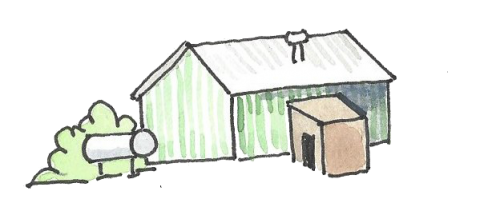 This is the garage where Rogie parks the tractors and has a man cave. That’s a chicken coop at the back.
This is the garage where Rogie parks the tractors and has a man cave. That’s a chicken coop at the back.
 This is one of many paddock shelters to protect the animals when the sun heats up their coats or raindrops start falling.
This is one of many paddock shelters to protect the animals when the sun heats up their coats or raindrops start falling.

This is Sky.
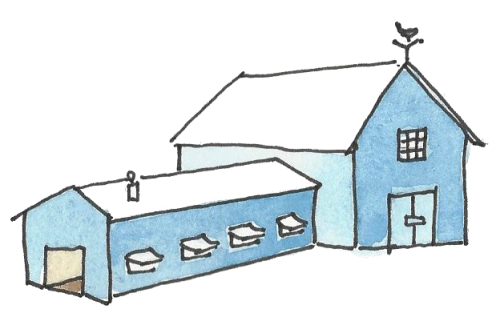 This is the barn where Sky and her friends live, including this wacky character, Tucker the mini paint.
This is the barn where Sky and her friends live, including this wacky character, Tucker the mini paint.
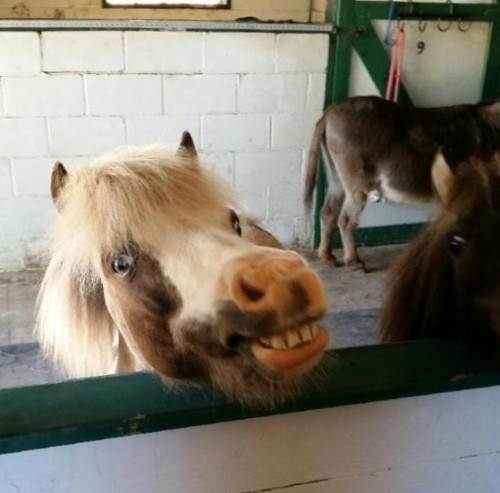
Don’t say the word “gingivitis” in front of him. (I’m kidding, Nicki takes great care of his teeth).

Tucker’s a little sensitive about the wandering eye.

Plug your nose, we’re going past the manure mound.
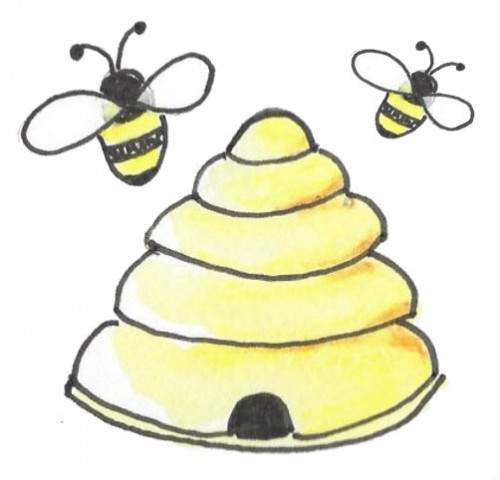
We’re so relieved the bees are back (for now).
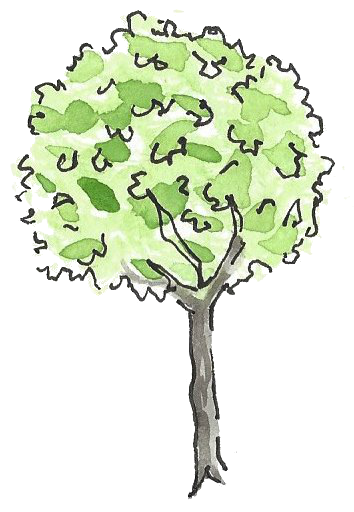
I knew I’d need some trees, so I prepared a maple that I could duplicate dozens of times (like a Flintstone background).
 I needed a few cedars too.
I needed a few cedars too.

Nicki even planted a wildflower patch.
While I was waiting for my paint to dry, I said to Rogie, “Send me the Google Earth view of the paddocks and barns.” And he did. I drew in the fences in black and the gates in red with a digital stylus.
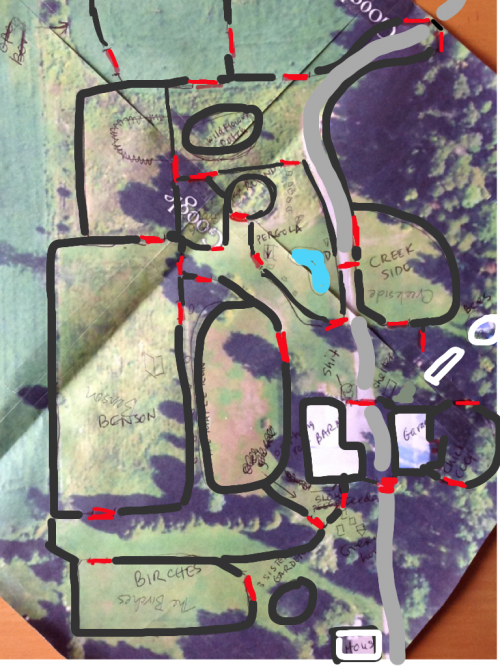
Looking things over, I decided a drawing of the farm would look better if I took the eye over the horizon. So I altered the image in Pixlr to create a vanishing point:
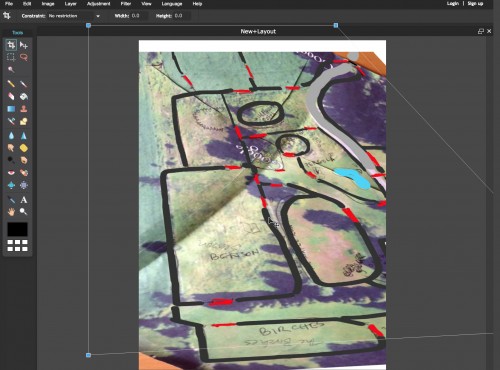
Then I created a base wash drawing:

Note how you can still see how the wetness of the watercolours created buckles and shadows on the paper. I brushed those out digitally, layered on my renderings of animals, trees and buildings and produced this final map:
Ta da!
This post was inspired by one of my favourite books, Austin Kleon‘s Show Your Work. If you think it’s imperative to hide your process from prying eyes, I encourage you to read this book and be open to changing your mind.








